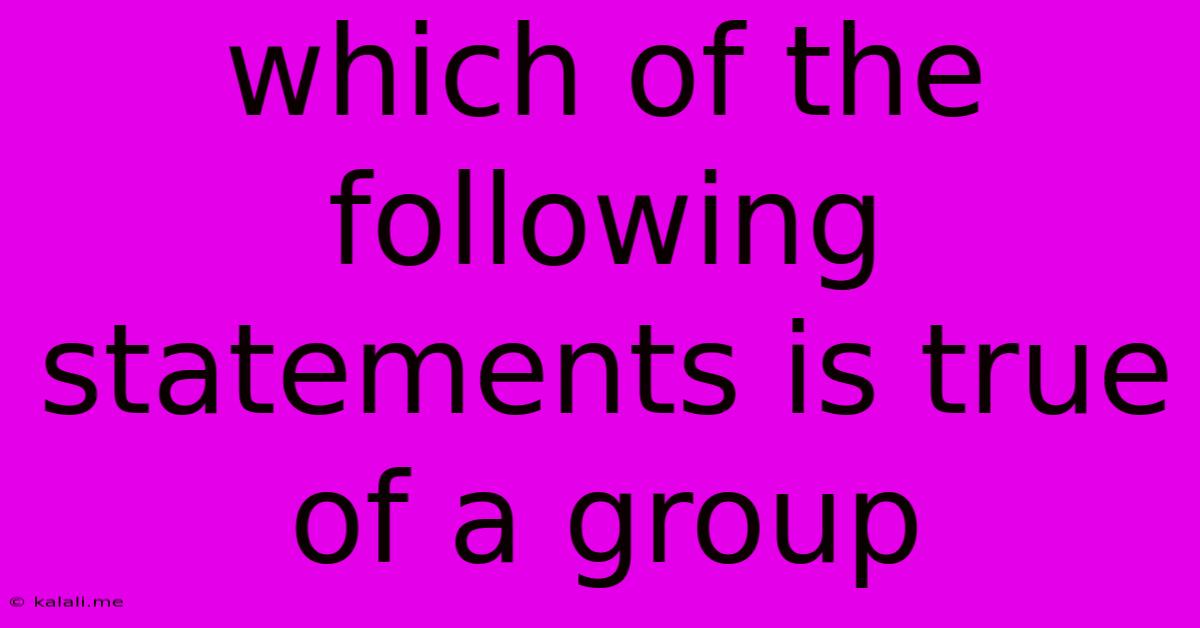Which Of The Following Statements Is True Of A Group
Kalali
Jun 14, 2025 · 3 min read

Table of Contents
Which of the Following Statements is True of a Group? Understanding Group Dynamics and Characteristics
This article explores the defining characteristics of a group, clarifying what constitutes a true group versus a mere collection of individuals. We'll delve into the key elements that differentiate a group from other social structures, focusing on the essential aspects that make a group a functional and cohesive unit. Understanding these distinctions is crucial in various fields, from sociology and psychology to organizational management and team building.
Meta Description: This article clarifies the defining characteristics of a group, distinguishing it from a simple collection of individuals. We explore key elements like interaction, shared goals, interdependence, and structure to understand what truly constitutes a group.
Defining Characteristics of a Group
Several statements might be presented regarding the nature of a group, but only some accurately reflect the true essence of group dynamics. Let's examine the common characteristics used to define a group:
-
Interdependence: A defining feature of a group is the interdependence of its members. Members rely on each other, directly or indirectly, to achieve individual and collective goals. This reliance fosters collaboration and interaction. A simple aggregation of individuals, like people waiting for a bus, lacks this interdependence.
-
Shared Goals: Groups typically form around shared goals or objectives. These goals may be implicit or explicit, but they provide a unifying force for the group's activities and interactions. The shared purpose binds members together and motivates collective action.
-
Structured Interaction: Meaningful interaction among members is paramount. It's more than just physical proximity; it involves communication, cooperation, and conflict resolution. This structured interaction differentiates a group from a mere crowd.
-
Sense of Belonging: Members usually develop a sense of belonging and identity associated with the group. This shared identity strengthens group cohesion and reinforces member commitment. This sense of belonging isn't necessarily present in all groups, but it's a common characteristic.
-
Group Norms: Groups tend to develop their own norms – unspoken or explicitly stated rules that guide behavior and interactions within the group. These norms contribute to the group's internal structure and stability.
-
Defined Roles: While not always formalized, groups often exhibit role differentiation. Members take on specific roles or responsibilities, contributing to the group's overall functioning.
Distinguishing Groups from Other Social Aggregates
It's important to distinguish a true group from other social aggregations:
-
Aggregates: These are collections of individuals who happen to be in the same place at the same time, but they lack the characteristics mentioned above. Examples include people at a concert or in a shopping mall.
-
Categories: Categories are collections of people who share a common characteristic, such as age, gender, or occupation. They don't necessarily interact or share goals.
-
Teams: Teams are a specific type of group, characterized by a high degree of collaboration, shared responsibility, and a clear focus on achieving a specific goal. They often have a more formal structure and are often performance-oriented.
Identifying a True Group
To determine if a statement accurately describes a group, consider the following:
Does the statement imply:
- Interaction among members?
- Shared goals or objectives?
- Interdependence among members?
- A sense of unity or belonging?
- The development of norms or roles?
If the statement includes these elements, it's more likely to be a true statement about a group. Conversely, statements describing merely a collection of individuals, lacking interaction or shared purpose, would not be true statements about a group.
Therefore, when faced with a question about the characteristics of a group, analyze the statement against these key elements of group dynamics to determine its validity. Understanding these crucial elements will allow you to accurately identify and analyze groups in various contexts.
Latest Posts
Latest Posts
-
Days To Celebrate In April 2024
Jun 14, 2025
-
What Is Not Found In A Animal Cell
Jun 14, 2025
-
What Is The Lcm Of 5 6 And 7
Jun 14, 2025
-
Part Of The Brain That Controls Heartbeat
Jun 14, 2025
-
Which Of The Following Is A Terrestrial Planet
Jun 14, 2025
Related Post
Thank you for visiting our website which covers about Which Of The Following Statements Is True Of A Group . We hope the information provided has been useful to you. Feel free to contact us if you have any questions or need further assistance. See you next time and don't miss to bookmark.